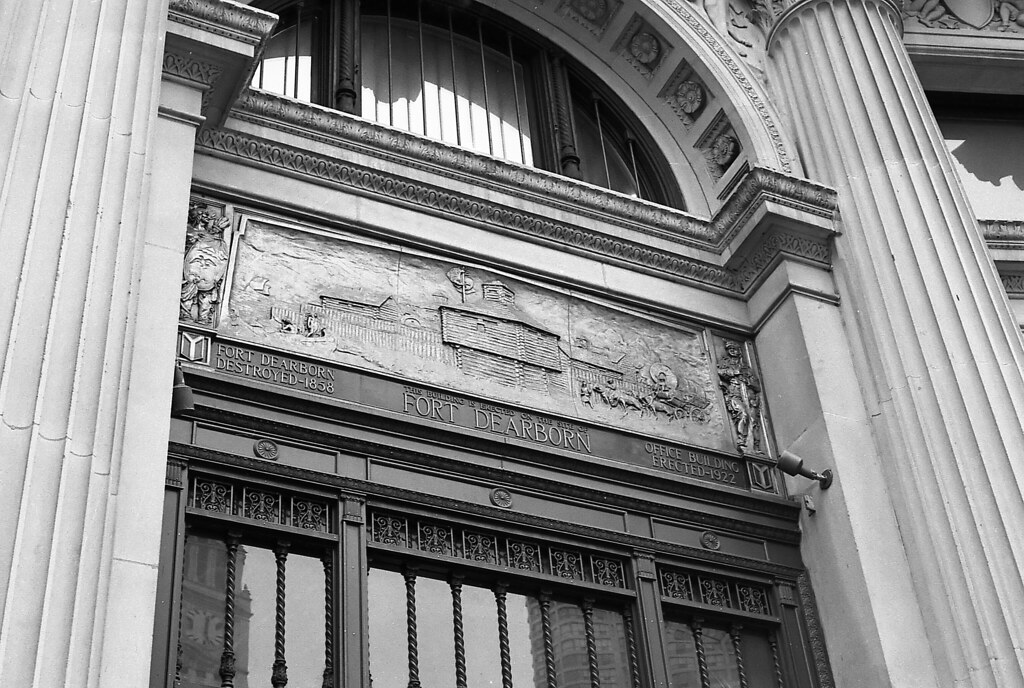The term battle is a bit misleading. The Battle of Fort Dearborn is one of the many skirmishes that took place in the old Northwest during the course of the Anglo-American War of 1812. The Indigenous peoples who decided to take advantage of the conflict further east began a campaign against American settlers and expansion by laying siege to the series of Forts established to aid in the colonisation of the American territories established after the Northwest Indian Wars of the previous century. Some of these sieges met with success, but after the defeat of the Americans at Mackinac Island, General William Hull began to consolidate the smaller posts, like Fort Dearborn on the Chicago River, into the larger forts to ensure a better defense. While the Battle of Fort Dearborn only lasted a short fifteen minutes, it remains the only connection to the War of 1812 for the residents of Chicago.

Nikon FM2n – AI-S Nikkor 50mm 1:1.4 – Kodak Tri-X 400 @ ASA-400 – Kodak HC-110 Dil. B 4:30 @ 20C
Fort Dearborn itself was built on the south shore of the Chicago river in 1804, named after US General Henry Dearborn (his name can still be found around the city). The small outpost and surrounding area mainly supported the fur trade. By the start of the war the outpost was commanded by Captain Nathan Heald overseeing a small garrison of fifty-four regulars and a small group of militia. By the time war had been declared in 1812 the fort itself was already under virtual siege from the local Indigenous peoples. Several attacks on the region kept the Americans barricaded behind the walls of the fort. When Fort Mackinac was captured by the British in July of 1812, William Hull, Commander of the US Forces in the area sent a dispatch to Fort Dearborn and Fort Wayne (in the Indiana Territory). The dispatch ordered that Captain Heald was to evacuate the fort at his earliest possible moment and retreat to the larger and much better defended Fort Wayne. Captain Wells, a veteran of the Northwest Indian War would arrive with escorts to help protect Heald’s column on their journey. Wells arrived in August of 1812 with a group of friendly native warriors from the Miami tribe. On 14 August Captain Heald notified the local Potawataomi tribe of their intention to leave. The local natives believed that Heald would turn over any surplus weapons, ammunition, and alcohol to them before they left. Heald was planning on doing no such thing, believing that the natives would put the items to poor use. The local chief, threatened the captain that he could not control his warriors any longer.

Hasselblad 500c – Carl Zeiss Distagon 50mm 1:4 – Rollei RPX 100 @ ASA-100 – Kodak HC-110 Dil. B 9:00 @ 20C
Hasselblad 500c – Carl Zeiss Distagon 50mm 1:4 – Rollei RPX 100 @ ASA-100 – Kodak HC-110 Dil. B 9:00 @ 20C
On the morning of 15 August 1812 Captain Heald and his column set out from Fort Dearborn. Captain Wells and some of his natives took the front and rear guard of the column. While the local militia of 12 men guarded the baggage train and the 9 women and 18 children along with Captain Heald and the US regulars. A mile and a half from the fort the column was ambushed by a group of 500 Potawatomi warriors. The friendly Miami allies quickly vanished, Wells was captured, scalped and beheaded during the initial attack, along with half of Heald’s regulars. Heald organized the remaining troops to attempt a counter attack, but in doing so separated themselves from the baggage column, the militia were quickly overwhelmed resulting in the death of most of the civilians and the militia. Upon their surrender the remaining regulars along with Captain Heald were taken back to the fort on the promise they would not be harmed. The natives did not hold up that promise, instead began to torture and kill the prisoners. A local fur trader, and friend of the Healds managed to secure their release through trade of a mule and some whiskey. The natives after killing the remaining prisoners burned the fort to the ground. Captain Heald and his wife managed to escape to Fort Mackinac, upon their arrival there, Captain Robarts, the British commander of the fort provided them with a sailboat and sent them down to Detroit.

Mamiya m645 – Mamiya-Sekor C 1:2.8 f=80mm – Lomography Potsdam 100 @ ASA-100 – Kodak HC-110 Dil. E 6:00 @ 20C
Nikon FM2n – AI-S Nikkor 50mm 1:1.4 – Kodak Tri-X 400 @ ASA-400 – Kodak HC-110 Dil. B 4:30 @ 20C
The American’s rebuilt Fort Dearborn in 1816, the fort continued to be manned until 1837. Slowly over the course of the mid-nineteenth century parts of the fort were removed to make way for the expanding city of Chicago that had grown up around the old fort. The fire of 1871 destroyed what was left of the fort. Today the intersection of Michigan Avenue and E. Wacker Drive sits where the fort once stood. A bronze plaque above the main entrance of the London Guarantee & Accident depicts the 1804 fort, the Michigan Avenue Bridge features the sculpture “Defense” honouring those killed in the battle. Another memorial sits in the Battle of Fort Dearborn park, where the battle actually took place at E 18th Street and S. Prairie Avenue. One of the stars on Chicago’s flag represents Fort Dearborn.
Written with files from:
Guidebook to the Historic Sites of the War of 1812 Second Edition by Gilbert Collins – 2006 The Dundurn Group Publishers
Web: www.warof1812.ca/batmac.html
Web: articles.chicagotribune.com/2012-08-14/opinion/ct-oped-0814-byrne-20120814_1_indian-country-fort-dearborn-massacre-potawatomis
Web: articles.chicagotribune.com/2012-08-15/opinion/ct-perspec-0815-dearborn-20120815_1_fort-dearborn-massacre-indian-country-indian-culture